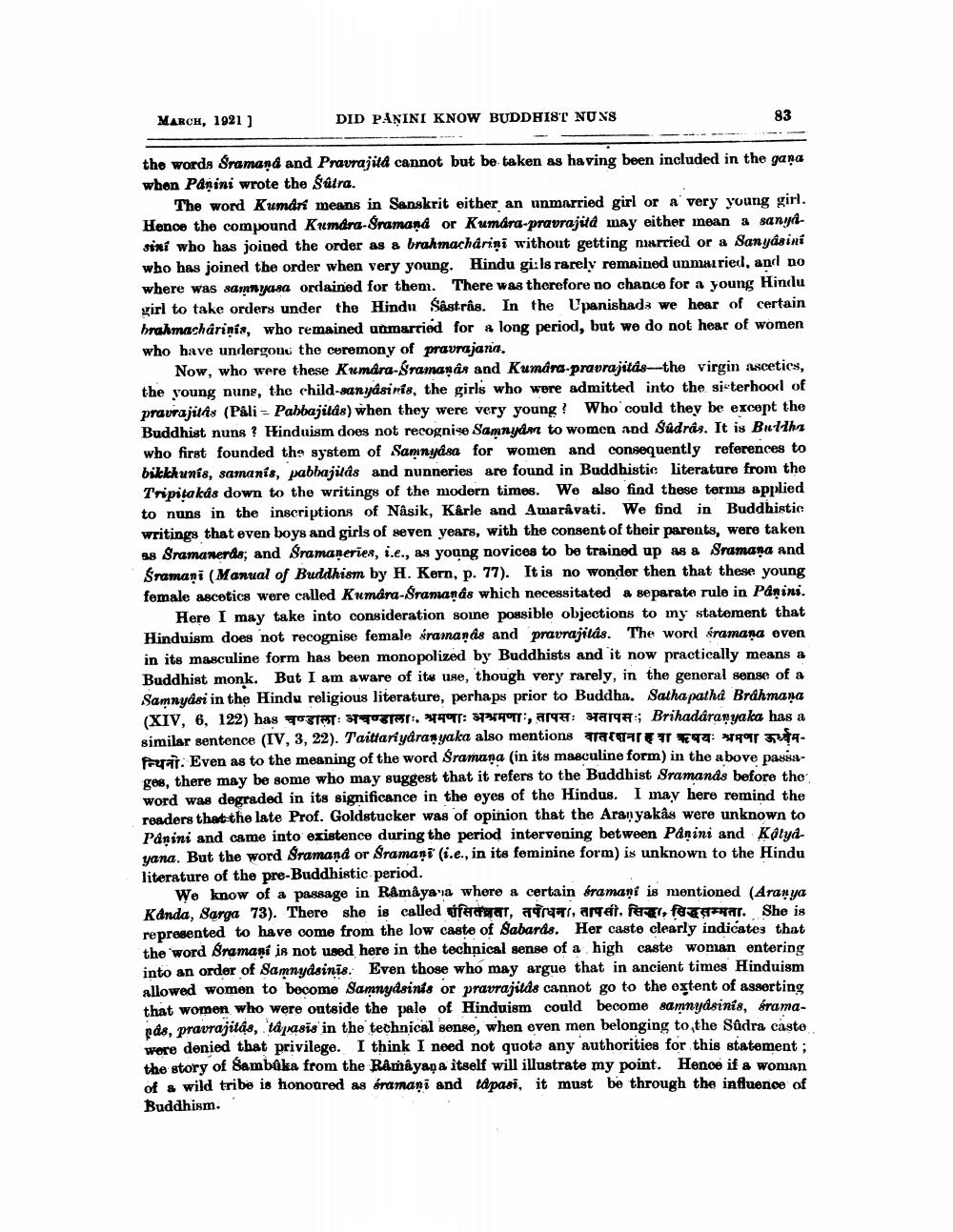________________
MARCH, 1921)
DID PAŞINI KNOW BUDDHIST NUNS
83
the words Sramand and Pravrajita cannot but be taken as having been included in the gaña when Panini wrote the Satra.
The word Kumari means in Sanskrit either an unmarried girl or a very young girl. Hence the compound Kremdra-Sramand or Kumara-pravrajità may either mean & sanyasini who has joined the order as a brahmacharini without getting married or a Sanyasini who has joined the order when very young. Hindu gi: Is rarely remained unmarried, and no where was samnyasa ordained for them. There was therefore no chance for a young Hindu girl to take orders under the Hindu Sastras. In the l'panishads we hear of certain brahmacharinis, who remained unmarried for a long period, but we do not hear of women who have undergonu the ceremony of pravrajana.
Now, who were these Kremdra-Srananas and Kumara-pravrajitas--the virgin ascetics, the young nuns, the child-sanyásinís, the girls who were admitted into the si-terhood of pravrajitas (Pali - Pahbajitás) when they were very young? Who could they be except the Buddhist nuns? Hinduism does not recognise Samnyime to women and Sudras. It is Bulha who first founded the system of Samnyása for women and consequently references to bikkhunís, samanis, pabbajilds and nunneries are found in Buddhistic literature from the Tripitakás down to the writings of the modern times. We also find these terms applied to nuns in the inscriptions of Nâsik, Kårle and Amaravati. We find in Buddhistic writings that even boys and girls of seven years, with the consent of their parents, were taken 98 Sramanerds; and Sramanerier, i.e., as young novices to be trained up as a Sramana and Sramani (Manual of Buddhism by H. Kern, p. 77). It is no wonder then that these young female ascetics were called Kumâna-Srananas which necessitated a separate rule in Panini.
Here I may take into consideration some possible objections to my statement that Hinduism does not recognise female sramands and pravrajitás. The word sramana oven in its masculine form has been monopolized by Buddhists and it now practically means a Buddhist monk. But I am aware of its use, though very rarely, in the general sense of a Samnyási in the Hindu religious literature, perhaps prior to Buddha. Sathapathd Brahmana (XIV, 6, 122) has
gor, 47: 374T, arge: warga; Brihadaranyaka has a similar sentence (IV, 3, 22). Taittari yaranyaka also mentions arcar T ET: T URA Prurat. Even as to the meaning of the word Sramana (in its masculine form) in the above passages, there may be some who may suggest that it refers to the Buddhist Sramands before the word was degraded in its significance in the eyes of the Hindus. I may here remind the readers that the late Prof. Goldstucker was of opinion that the Aranyakås were unknown to Panini and came into existence during the period intervening between Panini and Katydyana. But the word Sramand or Sramaņi (i.e., in its feminine form) is unknown to the Hindu literature of the pre-Buddhistic period.
We know of a passage in Ramayana where a certain eramani is mentioned (Aranya Kanda, Sarga 73). There she is called fhear, art, arcát, ferer, feughar. She is represented to have come from the low caste of Sabarás. Her caste clearly indicates that the word Bramani is not used here in the technical sense of a high caste woman entering into an order of Samnyasinis. Even those who may argue that in ancient times Hinduism allowed women to become Samnydsinis or pravrajitds cannot go to the oxtent of asserting that women who were outside the pale of Hinduism could become samnydsinís, óramands, pravrajilds, táprasis in the technical sense, when even men belonging to the Sadra caste were denied that privilege. I think I need not quota any authorities for this statement; the story of Samboka from the Ramayana itself will illustrate my point. Hence if a woman of a wild tribe is honoured as éramani and tapasi, it must be through the influence of Buddhism.




